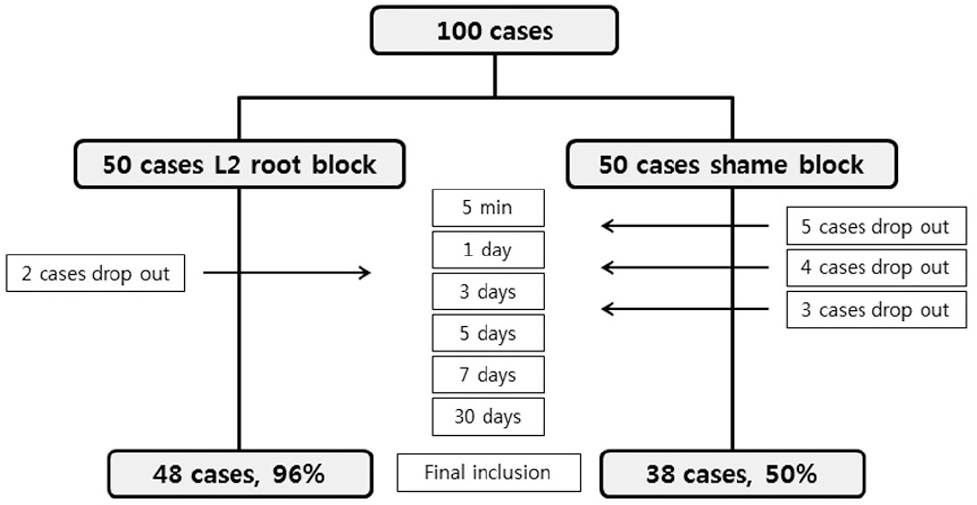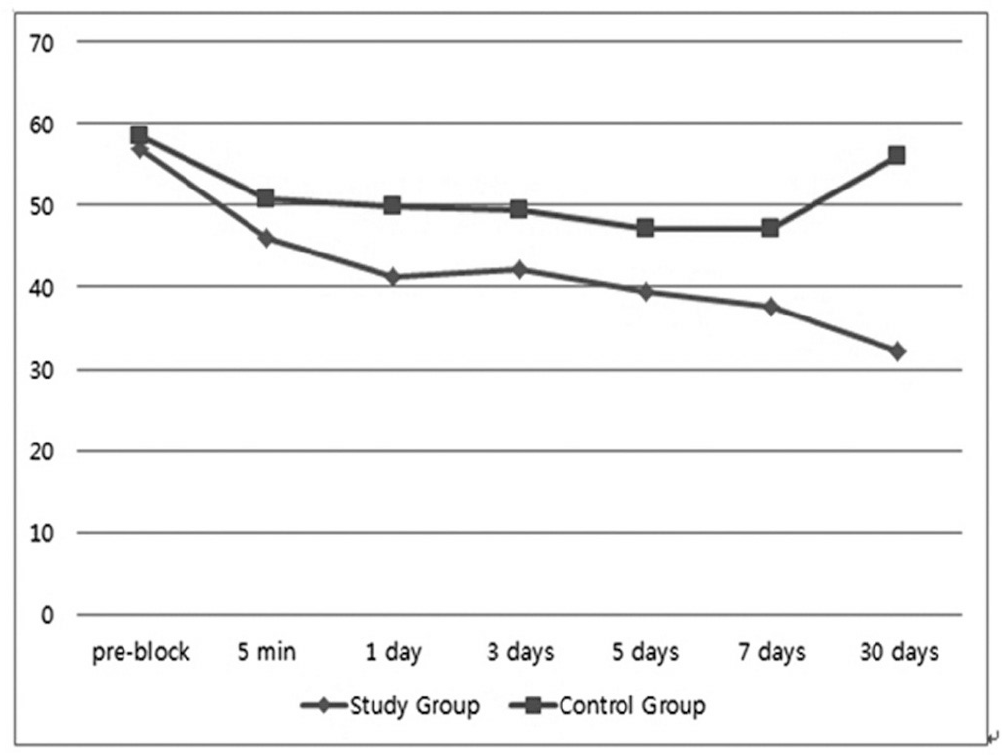Abstract
Objectives
The aim of the study was to verify the effectiveness of L2 spinal nerve root block for patients who are suffering from low back pain and referred pain with compound causes.
Summary of Literature Review
Most of low back pain and referred pain arises from discs, facet joints and sacroiliac joints. All structures above have the pain perception pathway through sympathetic nerves with a connection to L2 spinal nerves.
Materials and Methods
We selected patients with low back pain and referred pain for more than 2 weeks. Each 50 patients were randomly allocated to an experimental and a control group. The experimental group underwent a L2 spinal nerve root block with 2cc of 0.25% bupibacaine at the symptom dominant side. The control group underwent a skin infiltration with 2cc of 2% lidocaine only. The pain was assessed with a visual analogue scale (VAS) consisting of 100 points at 5minutes, day 1, day 3, day 5, day 7 and day 30 post-procedure.
Results
Both groups showed a significant improvement after the procedures(p=0.000). However, a greater improvement was shown in the experimental group(p=0.000). In the individual analysis, the experimental group had improved as time elapsed and the significancewas maintained until 30 days. However, in control group, the significance was lost at day 30.
REFERENCES
1. Cervero F. Visceral nociception: peripheral and central aspects of visceral nociceptive systems. Philos Trans R Soc Lond B Biol Sci. 1985; 308:325–37.
2. Nakamura SI, Takahashi K, Takahashi Y, Yamagata M, Moriya H. The afferent pathways of discogenic low-back pain. Evaluation of L2 spinal nerve infiltration. J Bone Joint Surg Br. 1996; 78:606–12.
3. Murata Y, Kato Y, Miyamoto K, Takahashi K. Clinical study of low back pain and radicular pain pathways by using l2 spinal nerve root infiltration: a randomized, controlled, clinical trial. Spine (Phila Pa 1976). 2009; 34:2008–13.
4. Murata Y, Takahashi K, Yamagata M, Takahashi Y, Shi-mada Y, Moriya H. Origin and pathway of sensory nerve fibers to the ventral and dorsal sides of the sacroiliac joint in rats. J Orthop Res. 2001; 19:379–83.

5. Murata Y, Takahashi K, Yamagata M, Takahashi Y, Shi-mada Y, Moriya H. Sensory innervation of the sacroiliac joint in rats. Spine (Phila Pa 1976). 2000; 25:2015–9.

6. Suseki K, Takahashi Y, Takahashi K, Chiba T, Tanaka K, Moriya H. CGRP-immunoreactive nerve fibers projecting to lumbar facet joints through the paravertebral sympathetic trunk in rats. Neurosci Lett. 1996; 221:41–4.

7. Jensen MC, Brant-Zawadzki MN, Obuchowski N, Modic MT, Malkasian D, Ross JS. Magnetic resonance imaging of the lumbar spine in people without back pain. N Engl J Med. 1994; 331:69–73.

8. DePalma MJ, Ketchum JM, Saullo T. What is the source of chronic low back pain and does age play a role? Pain Med. 2011; 12:224–33.

9. Laplante BL, Ketchum JM, Saullo TR, Depalma MJ. Multivariable Analysis of the Relationship between Pain Referral Patterns and the Source of Chronic Low Back Pain. Pain Physician. 2012; 15:171–8.
10. Boswell MV, Colson JD, Sehgal N, Dunbar EE, Epter R. A systematic review of therapeutic facet joint interventions in chronic spinal pain. Pain Physician. 2007; 10:229–53.
11. Manchikanti L, Singh V, Falco FJ, Cash KA, Fellows B. Comparative outcomes of a 2-year followup of cervical medial branch blocks in management of chronic neck pain: a randomized, double-blind controlled trial. Pain Physician. 2010; 13:437–50.
12. Liliang PC, Lu K, Liang CL, Tsai YD, Wang KW, Chen HJ. Sacroiliac joint pain after lumbar and lumbosacral fusion: findings using dual sacroiliac joint blocks. Pain Med. 2011; 12:565–70.

13. Liliang PC, Lu K, Weng HC, Liang CL, Tsai YD, Chen HJ. The therapeutic efficacy of sacroiliac joint blocks with triamcinolone acetonide in the treatment of sacroiliac joint dysfunction without spondyloarthropathy. Spine (Phila Pa 1976). 2009; 34:896–900.

14. Carragee EJ, Lincoln T, Parmar VS, Alamin T. A gold stan-dard evaluation of the “discogenic pain” diagnosis as determined by provocative discography. Spine (Phila Pa 1976). 2006; 31:2115–23.

15. Ness TJ, Gebhart GF. Visceral pain: a review of experiental studies. Pain. 1990; 41:167–234.
16. Groen GJ, Baljet B, Drukker J. Nerves and nerve plexuses of the human vertebral column. Am J Anat. 1990; 188:282–96.

17. Nakamura S, Takahashi K, Takahashi Y, Morinaga T, Shi-mada Y, Moriya H. Origin of nerves supplying the posterior portion of lumbar intervertebral discs in rats. Spine (Phila Pa 1976). 1996; 21:917–24.

18. Mendez R, Bailey S, Paine G, et al. Evaluation of the L2 spinal nerve root infiltration as a diagnostic tool for discogenic low back pain. Pain Physician. 2005; 8:55–9.
19. Ohtori S, Nakamura S, Koshi T, et al. Effectiveness of L2 spinal nerve infiltration for selective discogenic low back pain patients. J Orthop Sci. 2010; 15:731–6.

20. Ohtori S, Yamashita M, Inoue G, et al. L2 spinal nerve-block effects on acute low back pain from osteoporotic vertebral fracture. J Pain. 2009; 10:870–5.

21. Richardson J, Collinghan N, Scally AJ, Gupta S. Bilateral L1 and L2 dorsal root ganglion blocks for discogenic low-back pain. Br J Anaesth. 2009; 103:416–9.

23. El-Mahdi MA, Abdel Latif FY, Janko M. The spinal nerve root “innervation”, and a new concept of the clinicopatho-logical interrelations in back pain and sciatica. Neuro-chirurgia (Stuttg). 1981; 24:137–41.
24. Fairbank JC, Park WM, McCall IW, O'Brien JP. Apophy-seal injection of local anesthetic as a diagnostic aid in primary low-back pain syndromes. Spine (Phila Pa 1976). 1981; 6:598–605.

25. Suseki K, Takahashi Y, Takahashi K, et al. Innervation of the lumbar facet joints. Origins and functions. Spine (Phila Pa 1976). 1997; 22:477–85.
26. Bernard TN Jr, Kirkaldy-Willis WH. Recognizing specific characteristics of nonspecific low back pain. Clin Orthop Relat Res. 1987; 217:266–80.

27. Dreyfuss P, Michaelsen M, Pauza K, McLarty J, Bogduk N. The value of medical history and physical examination in diagnosing sacroiliac joint pain. Spine (Phila Pa 1976). 1996; 21:2594–602.

28. Maigne JY, Aivaliklis A, Pfefer F. Results of sacroiliac joint double block and value of sacroiliac pain provocation tests in 54 patients with low back pain. Spine (Phila Pa 1976). 1996; 21:1889–92.





 PDF
PDF ePub
ePub Citation
Citation Print
Print




 XML Download
XML Download